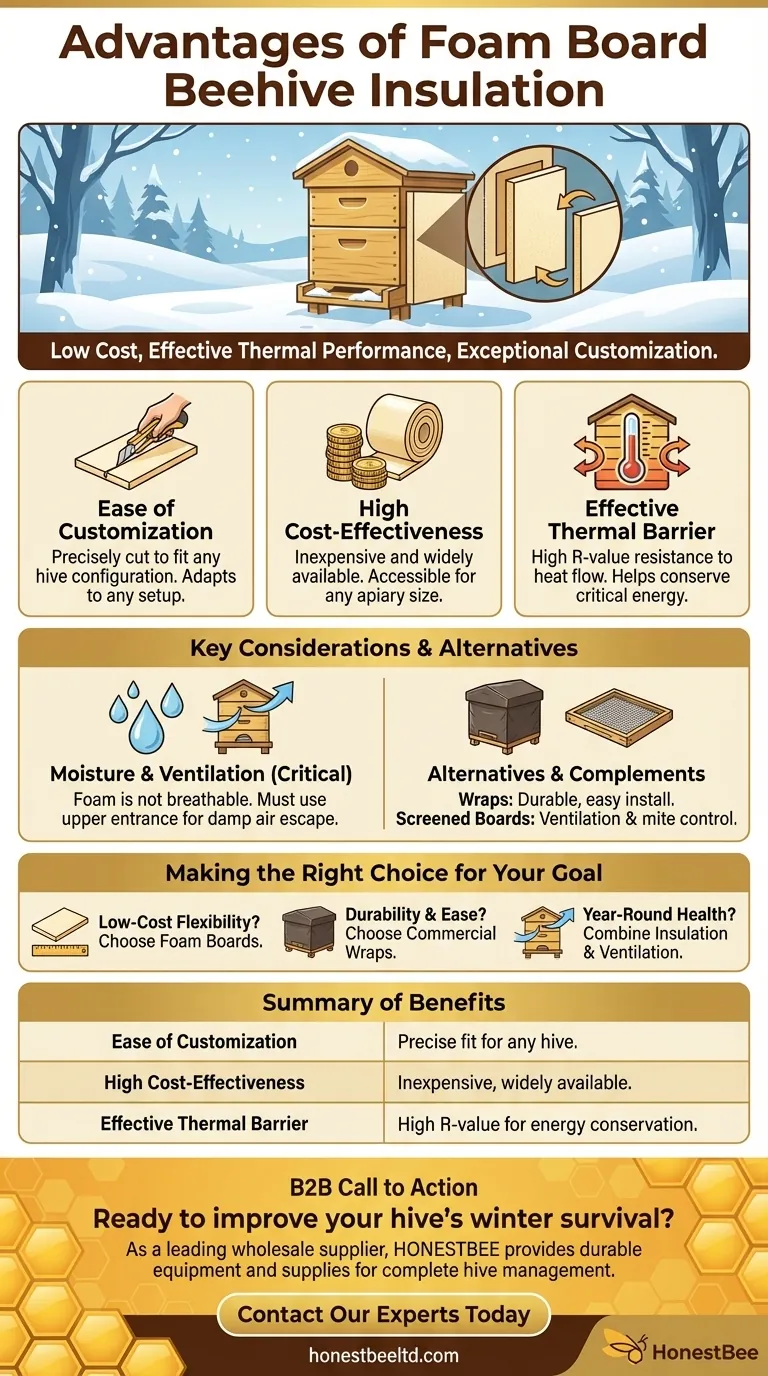The primary advantages of using foam boards for beehive insulation are their low cost, effective thermal performance, and exceptional ease of customization. Unlike pre-made wraps, rigid foam can be precisely cut to fit any hive configuration, providing a practical and budget-friendly way to help a colony regulate its internal temperature.
The central challenge for a beekeeper is helping a colony survive temperature extremes with minimal stress. Foam board insulation represents a highly adaptable and cost-effective tool to improve a hive's thermal efficiency, allowing bees to conserve critical energy reserves.

Why Insulation Matters for a Beehive
The Winter Cluster
During cold weather, honey bees form a tight "winter cluster" to generate and conserve heat. The bees on the inside vibrate their wing muscles to create warmth, while the bees on the outside form a dense, insulating shell.
Reducing Energy Consumption
Proper insulation reduces the rate at which heat escapes the hive. This means the cluster doesn't have to work as hard or consume as much of its precious honey stores to stay warm, increasing the colony's chances of surviving until spring.
Stabilizing Internal Temperatures
Insulation acts as a buffer against rapid temperature swings. This stability reduces stress on the colony and helps maintain a consistent environment for the queen and any developing brood.
The Core Advantages of Foam Board Insulation
Ease of Customization
Foam boards, typically made of polystyrene or polyurethane, are their own template. They can be easily cut with a utility knife to fit perfectly around the hive body, accommodate entrances, and work with any specific hive setup.
High Cost-Effectiveness
Compared to specialized beekeeping equipment, rigid foam insulation is widely available at hardware stores and is relatively inexpensive. This makes it an accessible option for beekeepers with any number of hives.
Effective Thermal Barrier
Foam provides a significant R-value, or resistance to heat flow. This barrier helps keep the warmth generated by the bee cluster inside the hive, acting much like the insulation in the walls of a house.
Understanding the Trade-offs and Alternatives
Critical Consideration: Moisture and Ventilation
While foam is an excellent insulator, it is not breathable. Trapped moisture from the bees' respiration is a greater threat than cold. Proper ventilation, such as an upper entrance, is absolutely essential when using foam boards to allow this damp air to escape.
Alternative: Commercial Insulation Wraps
Pre-made hive wraps are a common alternative. They are durable, easy to install, and often dark in color to absorb solar radiation. While less customizable than foam, they are designed specifically for hives and provide good insulation while allowing for some airflow.
Complementary Tool: Screened Bottom Boards
A screened bottom board is not insulation but is a key part of hive temperature and moisture management. It provides excellent ventilation during hot summers, helps dislodge Varroa mites, and can reduce the risk of moisture buildup, even in winter. Many beekeepers use them year-round.
Making the Right Choice for Your Goal
Selecting the right thermal strategy depends on your climate, budget, and beekeeping goals.
- If your primary focus is a low-cost, flexible solution: Foam boards are the ideal choice, as you can adapt them to any hive size or configuration.
- If your primary focus is durability and ease of installation: A commercial hive wrap is a more convenient, long-lasting, and purpose-built option.
- If your primary focus is year-round hive health: Combining insulation with proper ventilation, often using a screened bottom board, creates a more comprehensive management system.
Ultimately, the right insulation strategy helps your bees conserve precious energy, leading to a stronger and healthier colony.
Summary Table:
| Advantage | Key Benefit |
|---|---|
| Ease of Customization | Can be precisely cut to fit any hive configuration. |
| High Cost-Effectiveness | Widely available and inexpensive compared to specialized wraps. |
| Effective Thermal Barrier | Provides a high R-value to help bees conserve energy. |
Ready to improve your hive's winter survival with cost-effective solutions?
As a leading wholesale supplier to commercial apiaries and distributors, HONESTBEE provides the durable equipment and supplies you need to build a complete hive management system. Let us help you strengthen your colonies and operations.
Contact our experts today to discuss your beekeeping supply needs!
Visual Guide

Related Products
- Professional Insulated Winter Hive Wrap for Beekeeping
- Professional Bamboo Queen Isolation Cage
- 3D Beehive Silicone Skep Wax Candle Molds for Candles
- Plastic Beetle Blaster Trap Beekeeping Tools and Supplies
- Professional Beekeeping Suit for Kids and Girls Childrens Bee Keeper Suit
People Also Ask
- What factors ensure bees stay warm and healthy during winter? Master the 3 Keys to Hive Survival
- What are the durability features of Bee Blankets? Built to Last in Demanding Apiary Conditions
- Why is it important to insulate beehives during winter? Boost Your Colony's Survival Rate
- Why is insulation important for hives during winter? Ensure Your Bees Survive and Thrive
- What are the steps to properly wrap a beehive for winter? Ensure Your Colony Survives the Cold



















